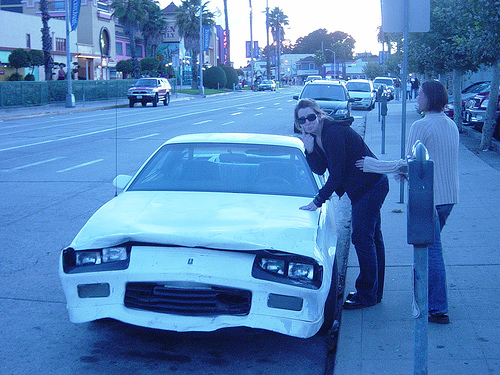In a story about the decline of youth car culture, the New York Times quotes an advertising exec on the feelings of today’s youth toward the auto:
“They think of a car as a giant bummer,” said Mr. Martin. “Think about your dashboard. It’s filled with nothing but bad news.”
True dat. I’m not young anymore, but looking at my gas gauge is one of the biggest downers of my day. Though as I’ve argued before, a big part of waning interest in cars among young people stems from economics rather than cultural shifts: gas and cars are expensive, youth unemployment is high, young peoples’ wages are down. And besides, new licensing laws have made it more difficult and costly for many teens to get a license, while making driving a lot less appealing. (When I was 16, the lure cruising around with friends was a major impetus for getting my license—but today licensing laws in many parts of the country forbid teens with new licenses to drive with a bunch of friends.)
Regardless of the reasons, the latest figures show that driving is continuing to decline—not simply among young people, but across the board…
- Year-end federal figures show that total miles logged on US roads fell by a little over a percent last year. Adjusting for population growth, that’s a decline of nearly 2 percent per person. Which isn’t a lot, but every little bit adds up. In fact, total vehicle travel in the US was lower in 2011 than it was in 2004.
- The declines in the Northwest—particularly Oregon—began earlier than the national trends, and have cut more deeply into car travel. By 2010, Oregonians had cut their total vehicle travel to roughly 1998’s levels. And measured per person, vehicle travel was at its lowest level since 1986.
I could go on (and on). But suffice it say that the data now leave no room for doubt: for all sorts of reasons, people have less appetite for car travel than they did just a few years back. A look at the demographics suggests that these trends could well continue, even as the economy recovers. Baby boomers are aging past their peak driving years, and are being replaced by the much smaller baby bust generation. Gas prices are showing no sign of a sustained drop. And meanwhile, young people just aren’t taking to the roads the way they used to.
It makes me wonder…why is it again that we’re planning to spend so many billions of dollars on big new roads?





Eric Doherty
New and wider roads are about stimulating demand for oil, steel and everything else that goes into an automobile dominated transportation system. It is about short changing transit and stimulating the kind of sprawl that coerces people into buying cars they can’t afford, and then buying gas they can’t afford.
How could we possibly keep expanding the tar sands without spending billions on this kind of social engineering?
Elisabeth Robson
Great news about the decline in car travel. We can only hope that people will continue to drive less and not use those big new roads and perhaps perhaps one day, the politicians will see the light? Doubtful… but we can hope!
Jeremy
Easter Island had a thing for statues, could be a similar cultural inertia there as with the road projects. Plus, the new wave of non-drivers likely aren’t yet old enough to directly influence policy at DOTs and other institutions. Give them another decade or two…
(My dad could name practically every model of car. Me? At a bus stop, someone once remarked “check out the somethingsomething” and I’m like well I see a green car and a white one and a gray one, help me out here?)
Alan Durning
Jeremy,
I LOVE your second paragraph. That’s how I am, too.
John Niles
Why build more highways when driving is down?
Two reasons occurring to me:
First, most people still drive cars at the rate of thousands of miles per capita per year to places they can’t or don’t want to walk to, bike to, or take transit to. The above chart of driving in Oregon does not show the line at zero, even though buses, trains, bike trails, and walking paths go to lots of places in Oregon.
Second, population is growing.